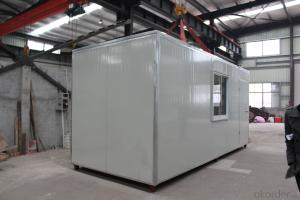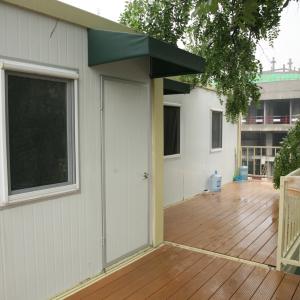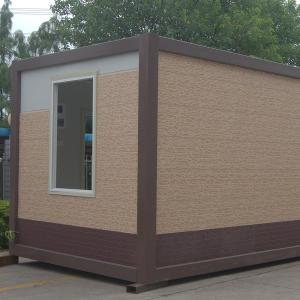Easy installation container house
- Loading Port:
- China Main Port
- Payment Terms:
- TT OR LC
- Min Order Qty:
- -
- Supply Capability:
- -
OKorder Service Pledge
OKorder Financial Service
You Might Also Like
Our advantages:
1. Qualification: CE(DIN18800), ISO9001, BV
2. Durable, beautiful, economic and environmental
3. High Construction Efficiency (2 worker in one day for one unit)
4. Long life time (Max. 20 years)
5. Easy to transport and assemble (Can load 7 units into one 40'HQ)
Brand Name: PTH
Our advantages:
1) Integrated base and roof, PU injected, excellent strength and tightness
2) 0.426mm color steel sheet for sandwich wall panel, strong and beautiful
3) All electric wires, water pipes, windows, doors and floor pre-setted, easy for assembling
4) Long time oversea project experience
5) 4S sales and service network, buy a house just like to buy a car
| standard | roof load | 0.5KN/sqm (can reinforce the structure as required) |
| Wind speed | designing wind speed: 210km/h (Chinese standard) | |
| seismic resistance | magnitudes 8 | |
| temperature | suitable temperature.-50°C~+50°C |
Usage: The small container house has the following features: light weight, convenient and fast assembling and shipment, many-times disassembling, high rate of reuse. It can be applied to office, command posts, dormitories, meeting rooms, warehouses, shops, additional storey on building roof and temporary houses in the field of building, railways, highways, water conservancy projects, electric power, oil, business, tourism, and military use. And the houses are air-tight, heat-insulating, warm-keeping, waterproof and anti-corrosive.
1. Easy to assemble and disassemble: The houses can be assembled and disassembled for dozens of times and can be reused for many times. And the assembling only needs simple tools and doesn’t need power source. The connections of the pieces of the house all adopt plugs or screw connections.
2. Strong Structure: It adopts steel frame structure, therefore it is stable and in line with the designing code of building structure.
3. Heat-insulation: The roof and wall are made of color steel sandwich panel (EPS, XPS, PU or Rock Wool) which have good heat-insulating and fire-proof performance.
4. Durable: The steel frame parts are all processed with anti-corrosion coating and it can be used as long as 20 years.
5. Environment protection: The design of the house is reasonable and it is easy to assemble and disassemble.
6. Diversified Specifications: Our design can be customized. The doors, windows and front and back walls can be exchanged each other. And the partition walls according to the customers’ requirements.
- Q: Can container houses be designed with a fireplace?
- Container houses can incorporate a fireplace without a doubt. Despite the challenges posed by their small size and unconventional structure, it is entirely feasible to design container houses with a fireplace. Designing a container house with a fireplace necessitates considering a few factors. Firstly, the weight of the fireplace and chimney must be taken into account to ensure the structural integrity of the container. It may be necessary to reinforce the walls or foundation to support the additional weight. Secondly, careful planning is required for ventilation and safety aspects. Proper air circulation must be ensured, and measures should be taken to prevent the accumulation of smoke or carbon monoxide. Using fire-resistant materials and insulation is crucial to protect the container from potential fire hazards. Lastly, the choice of fireplace size and type should be made judiciously to suit the available space and the overall design aesthetic of the container house. Depending on the homeowner's preferences and needs, space-saving options such as compact wood-burning stoves or electric fireplaces can be considered. In conclusion, while it may demand meticulous planning and adjustments, container houses can indeed be designed with a fireplace, providing warmth and coziness to the living space.
- Q: Can container houses be built with a home automation system?
- Certainly, container houses can be constructed with a home automation system in place. By utilizing a home automation system, one can effectively integrate and manage various electronic devices and systems within the container house. These encompass, but are not confined to, lighting, heating and cooling systems, security cameras, door locks, and entertainment systems. Through the assistance of sensors, controllers, and a central hub, the home automation system can offer convenience, energy efficiency, and heightened security to the inhabitants of the container house. Furthermore, the adaptable nature of container houses makes it comparably simpler to install and personalize the home automation system to meet the specific requirements and preferences of the homeowners. Whether it involves remotely adjusting the temperature, scheduling automated lighting, or monitoring the security of the house via a smartphone, container houses can unquestionably reap the advantages of incorporating a home automation system.
- Q: Can container houses be designed for outdoor recreational areas?
- Yes, container houses can be designed and built for outdoor recreational areas. Container houses offer versatility in design and can be customized to fit specific purposes, including outdoor recreational areas. They can be modified with various features such as outdoor decks, swimming pools, or even integrated into larger recreational complexes. Container houses are durable and weather-resistant, making them suitable for outdoor environments.
- Q: Are container houses customizable in terms of size?
- Yes, container houses are customizable in terms of size. They can be modified and combined to create various layouts and sizes based on individual needs and preferences.
- Q: Can container houses be designed to have a pet-friendly layout?
- Certainly, container houses can be designed in a way that accommodates pets. When planning a container house with pets in mind, there are several important factors to take into consideration. First and foremost, it is crucial to ensure that there is sufficient space for pets to move around comfortably. Modifications can be made to the containers to create larger living areas or even multiple levels, providing ample room for pets to play and explore. Another key aspect to consider is the use of pet-friendly materials and finishes in the design. Opting for durable flooring materials like laminate, tile, or vinyl makes it easier to clean up any messes or accidents. Additionally, using scratch-resistant materials for walls and furniture can help protect against damage caused by pets. Creating designated spaces for pets within the house is also essential. This could involve incorporating built-in pet beds or crates, as well as establishing dedicated play or exercise areas. These designated spaces will give pets a sense of ownership and comfort within the home. Furthermore, ensuring sufficient natural light and ventilation is important for the well-being of pets. Installing large windows or skylights allows pets to enjoy a view of the outside and promotes natural airflow, contributing to a healthier environment for them. Lastly, it is crucial to prioritize the safety of pets within the container house. This may involve installing pet-friendly gates or barriers to restrict access to certain areas, as well as securing windows and balconies to prevent accidents or escapes. In conclusion, by considering factors such as space, materials, designated areas, natural light, ventilation, and safety, container houses can be designed to be pet-friendly. With careful planning and design, container houses can offer a comfortable and enjoyable living experience for both humans and their furry companions.
- Q: Can container houses be designed to have a pet-friendly space?
- Yes, container houses can be designed to have a pet-friendly space. With proper planning and design, features such as designated areas for pet beds, litter boxes, and pet-friendly flooring options can be incorporated into the layout. Additionally, considering easy access to outdoor spaces, such as a fenced yard or a balcony, can provide pets with the necessary exercise and fresh air.
- Q: Can container houses be designed with a wine cellar or wine room?
- Yes, container houses can be designed with a wine cellar or wine room. With proper planning and design, containers can be modified to accommodate temperature and humidity control, ensuring optimal conditions for storing wine. The size and layout of the container can be adjusted to create a dedicated space for wine storage, complete with appropriate insulation, ventilation, and shelving systems.
- Q: What are the different sizes of container houses available?
- To accommodate different needs and preferences, container houses are available in various sizes. The standard lengths used in shipping are 20-foot and 40-foot containers. A 20-foot container house typically provides approximately 160 square feet of living space, while a 40-foot container house offers around 320 square feet. However, these sizes can be altered and combined to create larger spaces. For example, some container houses are constructed by joining two 20-foot containers together, effectively doubling the living area to 320 square feet. Additionally, multiple containers can be stacked or connected to create multi-level or more spacious homes. Furthermore, container houses can be personalized by adding features such as decks, balconies, and extensions, which further expand the available living space. These modifications allow for flexibility in design and allow individuals to customize their container houses according to their specific requirements. It's important to note that although the aforementioned sizes are commonly used, container houses can also be built using smaller or larger containers depending on the desired outcome. The size of a container house ultimately depends on factors such as budget, purpose, and the number of occupants.
- Q: Can container houses be built with a covered patio or outdoor kitchen?
- Yes, container houses can be built with a covered patio or outdoor kitchen. The versatility of container homes allows for various customization options, including adding a covered patio or outdoor kitchen. These features can enhance the living space by providing additional areas for relaxation and entertainment.
- Q: Can container houses be moved?
- Yes, container houses can be moved. They are designed to be easily transportable and can be loaded onto trucks, ships, or trains. This mobility allows for flexibility in relocating container houses to different sites if desired.
Send your message to us
Easy installation container house
- Loading Port:
- China Main Port
- Payment Terms:
- TT OR LC
- Min Order Qty:
- -
- Supply Capability:
- -
OKorder Service Pledge
OKorder Financial Service
Similar products
Hot products
Hot Searches
Related keywords
























